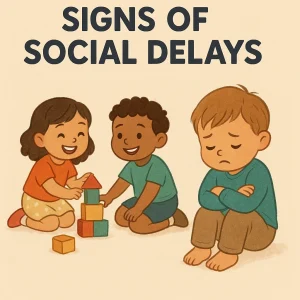Clinical Perspectives on Virtual Autism: How to Manage It
Last Updated: September 26, 2024
In today’s digital age, where screens are ubiquitous, a growing concern among parents and healthcare professionals is virtual autism management. This emerging condition refers to autism-like symptoms that some children develop due to excessive screen time, particularly at an early age. Children who spend too much time on tablets, phones, or TVs may exhibit delays in language development, difficulty with eye contact, and struggles in social interaction, mirroring the symptoms observed in children on the autism spectrum.
Understanding Virtual Autism
What is Virtual Autism, and How Does It Differ from Traditional Autism?
Virtual autism is a relatively new term that describes autism-like behaviors in children, which appear to be triggered by excessive screen exposure at a young age. Traditional autism, or Autism Spectrum Disorder (ASD), is typically associated with genetic and neurological factors, affecting a child’s ability to communicate and interact with others from birth. In contrast, virtual autism tends to develop as a result of environmental factors, particularly prolonged and unstructured screen time during early developmental stages.
While both conditions share similar traits, such as difficulties with communication, social interaction, and behavior regulation, the key difference lies in their origins. Virtual autism symptoms may often reduce or even disappear when screen time is significantly limited, and structured face-to-face interactions are encouraged. Traditional autism, on the other hand, is a lifelong condition that requires ongoing support and intervention.
Also Read: Virtual Autism vs. Autism: What Parents Need to Know
The Impact of Excessive Screen Time on Development
It’s no secret that screen time is a big part of modern life. However, too much of it, especially in young children, can have unintended effects. Excessive screen time can interfere with the brain’s natural development, particularly in areas responsible for language acquisition, emotional regulation, and social skills. Children learn these vital skills through real-world interaction, such as playing with peers, observing facial expressions, and engaging in conversations. When screen-based activities replace these interactions, children may miss out on essential developmental experiences.
Moreover, passive screen consumption—like watching videos or playing repetitive games—doesn’t encourage problem-solving, creativity, or social interaction, all of which are crucial for cognitive growth. This is why children who spend more time on screens and less time engaged in hands-on, interactive activities are at a higher risk of developing virtual autism symptoms.
Common Signs and Symptoms of Virtual Autism
Recognizing the signs of virtual autism early is key to managing it effectively. Here are some common symptoms parents and caregivers should look out for:
- Delayed Speech: Children may have trouble forming words or speaking in full sentences at the appropriate age.
- Lack of Eye Contact: Children may avoid eye contact or have difficulty maintaining it during interactions.
- Social Withdrawal: Children may seem disinterested in playing with others, preferring screen-based activities instead.
- Repetitive Behavior: They may exhibit repetitive motions or fixate on specific screen activities, like tapping or swiping.
- Difficulty Following Instructions: Virtual autism may also manifest in a child’s inability to understand and follow simple instructions.
Clinical Perspectives on Virtual Autism
How Pediatricians, Psychologists, and Autism Specialists View Virtual Autism
Healthcare professionals, especially pediatricians, psychologists, and autism specialists, are paying closer attention to the concept of virtual autism as it becomes a growing concern among parents and caregivers. Many clinicians view virtual autism as a modern developmental issue directly linked to excessive screen time in early childhood. Unlike traditional autism, which has well-documented neurological and genetic roots, virtual autism is seen as an environmental factor-induced condition, often reversible if caught early.
Professionals emphasize that virtual autism mirrors several traits of traditional autism, such as delayed speech, poor social interaction, and repetitive behaviors. However, the improvement of symptoms through non-digital intervention strategies, such as limiting screen time and increasing social play, sets it apart from Autism Spectrum Disorder (ASD). Clinicians stress that while virtual autism is real, proper diagnosis and management can significantly improve outcomes.
Differentiating Virtual Autism from Other Developmental Disorders
One of the biggest challenges for clinicians is distinguishing virtual autism from other developmental disorders. In children with traditional autism, symptoms often appear early and persist despite various interventions. For children with virtual autism, however, symptoms may be transient and closely linked to screen time habits. This differentiation is crucial because treatment approaches differ—while traditional autism requires ongoing therapeutic support, virtual autism may benefit significantly from environmental changes like reducing digital exposure.
Clinicians also carefully assess for other developmental issues, such as ADHD or speech delays, to ensure they are not misdiagnosing children with virtual autism. Differentiating between these conditions requires a thorough understanding of the child’s home environment, digital habits, and interactions with caregivers.
Challenges Clinicians Face in Diagnosing Virtual Autism
Diagnosing virtual autism presents several challenges for healthcare professionals. Unlike traditional autism, virtual autism is not widely recognized in diagnostic manuals like the DSM-5, which creates a barrier for standardized evaluation. Clinicians must rely heavily on behavioral assessments, parent reports, and developmental screenings to determine whether a child’s symptoms are tied to excessive screen use.
Another challenge is the variability in symptoms—some children may show severe signs of virtual autism while others may exhibit only mild delays. This makes it difficult for clinicians to establish clear-cut diagnostic criteria. Moreover, the rapid technological advances and changing patterns of screen time mean that clinicians must continually adapt their approach to virtual autism diagnosis.
Importance of Early Diagnosis and Intervention
The consensus among experts is clear: early diagnosis and intervention are critical for effectively managing virtual autism. Identifying the condition early gives parents and caregivers the chance to make lifestyle adjustments, such as reducing screen time and encouraging more face-to-face interaction. Early interventions can lead to significant improvements in communication, social behavior, and cognitive development.
Clinical professionals, including speech therapists and behavioral specialists, often recommend a combination of therapies such as speech therapy, structured play, and sensory activities to help children overcome the symptoms of virtual autism. Early intervention not only helps reverse some symptoms but also prevents long-term developmental delays.
Read more about Top Early Intervention Tips for Virtual Autism
Key Symptoms and Diagnostic Criteria
Behavioral Symptoms of Virtual Autism
Children with virtual autism often exhibit a range of behavioral symptoms that closely resemble those of Autism Spectrum Disorder (ASD). These symptoms may become noticeable as screen time increases and social interaction decreases. Some of the most common behavioral symptoms include:
- Delayed Speech Development: One of the first signs parents may notice is that their child is not meeting speech milestones. While many children begin forming words and simple sentences by age two, children with virtual autism may show delays in speaking or may communicate minimally.
- Lack of Eye Contact: Eye contact is a critical part of non-verbal communication, especially for young children. Those with virtual autism may avoid direct eye contact, which can affect their ability to engage in social interactions and build emotional connections.
- Social Withdrawal: These children may also show less interest in interacting with family members, caregivers, or peers. Instead of engaging in face-to-face play or conversation, they may become increasingly absorbed in their screens, leading to a sense of isolation.
Cognitive Issues Linked to Virtual Autism
Beyond behavioral symptoms, children with virtual autism may also struggle with certain cognitive issues. These can affect their ability to process information, problem-solve, and maintain focus. Key cognitive issues include:
- Attention Deficits: With excessive screen exposure, children may find it challenging to focus on tasks that require sustained attention, like playing with toys, solving puzzles, or even listening to stories. This could be due to the fast-paced, overstimulating nature of digital content.
- Problem-Solving Difficulties: Traditional play encourages creativity and critical thinking, but children who spend too much time on screens may miss out on these opportunities. As a result, they might struggle with basic problem-solving skills, which can hinder their cognitive development.
Diagnostic Tools and Techniques Used by Clinicians
Diagnosing virtual autism requires a careful and nuanced approach from clinicians. Since virtual autism is not yet a formally recognized diagnosis in most medical manuals, healthcare providers often rely on a combination of developmental screenings, parent interviews, and behavioral observations to assess the child’s condition.
- Developmental Screenings: Clinicians use age-appropriate developmental assessments to see if a child is meeting key milestones in language, social interaction, and motor skills. If delays are present, this may be an early indication of virtual autism, especially when linked to high screen use.
- Parent Interviews: Parents provide critical insights into their child’s daily habits, particularly around screen time and social interaction. Clinicians often ask parents about their child’s communication skills, play behavior, and attention span to better understand the impact of screen exposure.
- Behavioral Observations: Observing how the child interacts with their environment, family members, and peers is another essential tool. Clinicians may look for signs of social withdrawal, eye contact avoidance, and communication delays to confirm whether the child’s symptoms align with virtual autism.
Managing Virtual Autism: Effective Strategies
Reducing Screen Time: Why It’s Essential and How to Implement It Effectively
One of the first and most critical steps in managing virtual autism is to reduce screen time. Excessive screen exposure can overstimulate young minds, leading to delays in social and cognitive development. Cutting back on screen time helps children refocus on real-world interactions, which are crucial for emotional and social growth.
How to implement it effectively:
- Set clear boundaries for device use, like designating screen-free zones or hours.
- Encourage alternative activities such as reading, outdoor play, or art.
- Gradually reduce screen time rather than removing it all at once to avoid resistance. By creating a structured approach to screen time reduction, parents can help their children engage more in face-to-face interactions and sensory-rich environments.
Know more: Managing Screen Time: Parental Tips for Preventing Virtual Autism
Encouraging Face-to-Face Interaction: Fostering Real-World Social Engagement
Face-to-face interaction is vital for children to develop communication skills and emotional intelligence. Real-world interactions, like playing with siblings or talking with family, foster the kind of social growth that screens cannot provide. Children learn to read body language, understand emotional cues, and practice eye contact—all essential skills that can become underdeveloped with too much screen use.
Tips for fostering interaction:
- Create opportunities for social playdates with peers.
- Engage in simple family conversations during meals or while doing activities together.
- Practice interactive games like peek-a-boo or storytelling, which promote attention and interaction.
Incorporating Sensory Activities: Stimulating Cognitive and Sensory Development
Sensory activities play a crucial role in helping children with virtual autism reconnect with their environment. These activities stimulate different senses, encouraging better motor skills and cognitive processing. Sensory play helps children explore textures, sounds, and visuals, which can reignite their natural curiosity and focus away from the digital world.
Examples of sensory activities:
- Sensory bins filled with sand, rice, or water for tactile exploration.
- Using musical instruments or playing with sound-producing toys to engage auditory senses.
- Simple outdoor activities like playing in the sand or splashing in water provide both sensory input and physical exercise.
Structured Playtime: The Benefits of Play-Based Therapies in Reducing Symptoms
Structured playtime is an essential tool for children with virtual autism. Through play, children can practice communication, problem-solving, and social interactions in a natural, enjoyable way. Play-based therapies, such as role-playing games or building activities, help children strengthen their ability to focus and engage with their environment without screens.
Benefits of structured play:
- Enhances creativity and cognitive flexibility.
- Promotes collaboration and turn-taking during group activities.
- Encourages emotional expression, helping children manage their feelings better.
Speech and Language Therapy: Addressing Communication Issues
For children with delayed speech or communication difficulties due to virtual autism, speech and language therapy is a powerful intervention. Speech therapists work closely with children to improve their vocabulary, comprehension, and ability to communicate effectively. This type of therapy can significantly reduce the impact of screen-induced delays in language development.
How therapy helps:
- It focuses on teaching children to articulate their needs and feelings.
- Therapists often use play-based methods to make speech exercises fun and engaging.
- It helps children catch up on milestones that might have been delayed by excessive screen time.
Implementing Routines: The Importance of Structure and Consistency
Children with virtual autism often thrive on routine. Establishing a predictable daily structure helps them feel more secure and less anxious, especially as they transition away from heavy screen use. Routines create a sense of order and help children anticipate what comes next, making it easier for them to engage in activities that promote development.
Effective routine tips:
- Set consistent times for meals, naps, play, and learning activities.
- Incorporate screen-free time blocks into the daily routine, replacing them with face-to-face interactions or physical play.
- Ensure that bedtime routines are calming and screen-free, as this supports better sleep patterns and overall health.
Parental Guidance for Managing Virtual Autism
Educating Parents About Setting Boundaries on Screen Use
One of the most effective ways to manage virtual autism is by setting clear boundaries on screen time. Educating parents on how to balance their child’s exposure to screens is crucial. Excessive screen use, particularly during a child’s early developmental years, can negatively impact their social, emotional, and cognitive growth. Therefore, setting consistent limits is key.
Practical tips for setting boundaries:
- Establish screen-free zones: Designate specific areas in the home, such as the dining room or bedrooms, where screens are off-limits.
- Create screen-free time blocks: Set a schedule that includes breaks from digital devices, especially during meals and before bedtime.
- Involve children in decision-making: Discuss the importance of screen limits with your child, encouraging them to choose alternative activities like reading, outdoor play, or creative tasks.
Screen Time vs. Social Interaction Activities
| Screen Time Activity | Alternative Social Interaction | Explanation |
| Watching Cartoons | Playing with Toys (e.g., building blocks, puzzles) | Encourages creativity, fine motor skills, and problem-solving through hands-on play. |
| Video Games | Outdoor Sports or Active Play | Physical activities such as running, jumping, or playing ball games build motor skills and promote social interaction. |
| YouTube Videos | Reading Books Together | Enhances language development, imagination, and emotional bonding through shared reading experiences. |
| Educational Apps | Face-to-Face Learning Games (e.g., board games) | Games like board games or simple group activities improve communication, turn-taking, and real-world learning. |
| Interactive Digital Toys | Sensory Play (e.g., sand, water, or play dough) | Engages multiple senses, helping children with cognitive and sensory development in a hands-on environment. |
How to Create a Supportive and Interactive Home Environment
Building a supportive and interactive home environment is essential for fostering a child’s development. Children learn best when they are encouraged to explore, play, and engage with their surroundings. A home environment that prioritizes real-world experiences over digital ones helps children develop crucial skills, such as communication, problem-solving, and emotional regulation.
Ways to create a more interactive environment:
- Encourage physical play: Engage children in activities like building blocks, arts and crafts, or role-playing games that stimulate both their creativity and motor skills.
- Promote family interaction: Schedule regular family time, such as playing board games or taking walks together, to encourage bonding and conversation.
- Use sensory-rich experiences: Introduce children to different textures, sounds, and activities, like cooking or gardening, that engage their senses and improve cognitive development.
Building a Strong Support Network
Parenting a child with virtual autism requires a team approach. Building a strong support network of healthcare providers, therapists, and educators can make a world of difference. These professionals offer insight and support to ensure that the child’s developmental milestones are met and that any challenges are addressed early.
How to build a support network:
- Work with therapists and healthcare professionals: Regular check-ins with pediatricians, speech therapists, and occupational therapists can help track your child’s progress and adjust interventions as needed.
- Collaborate with educators: Teachers play a crucial role in your child’s development. Keep an open line of communication with them to ensure consistency between home and school.
- Connect with other parents: Parenting a child with virtual autism can feel isolating, but joining support groups or connecting with other parents can provide emotional support and shared experiences.
Conclusion
Virtual autism is becoming more common due to the increase in screen time, but with the right approach, its effects can be managed. Healthcare professionals emphasize that reducing screen exposure and encouraging activities like face-to-face interaction and sensory play can help children improve. Early intervention is critical because the sooner the signs of virtual autism are addressed, the better the outcome. Therapies such as speech and language therapy and structured routines can significantly boost a child’s development and reduce symptoms over time.
Parents are also encouraged to seek professional help from therapists, pediatricians, and educators to support their child’s progress. Consistent management is key, and it’s important to keep track of any improvements. Platforms like Wellness Hub provide resources and guidance to help families manage virtual autism with the right tools and support. With these strategies, children can grow and thrive, while families can feel more confident in managing their child’s needs.
Frequently Asked Questions:
1. What is virtual autism, and how does it differ from traditional autism?
Virtual autism refers to autism-like symptoms in children caused by excessive screen time. Unlike traditional autism, which is primarily linked to genetic and neurological factors, virtual autism is often tied to environmental influences like screen overexposure.
2. Can virtual autism be reversed?
Yes, in many cases, symptoms of virtual autism can improve or even disappear when early intervention is applied, such as reducing screen time and encouraging more face-to-face interactions and sensory activities.
3. How does screen time affect a child’s development?
Excessive screen time can lead to developmental delays, including delayed speech, lack of eye contact, and social withdrawal. It can hinder a child’s ability to engage with their surroundings and develop essential social and cognitive skills.
4. What are the key symptoms of virtual autism?
Common symptoms include delayed speech, limited eye contact, social withdrawal, attention deficits, and difficulty with problem-solving. These symptoms often mirror those of Autism Spectrum Disorder (ASD).
5. How can parents manage virtual autism at home?
Parents can manage virtual autism by reducing screen time, encouraging sensory-rich play, fostering face-to-face interactions, and creating structured routines. Consistent management and involvement in their child’s development are crucial.
6. What role do digital platforms play in managing virtual autism?
Digital platforms like telehealth services and speech therapy apps can support children with virtual autism by offering structured interventions. However, balancing therapeutic screen time with face-to-face interaction is key.
7. What is Applied Behavior Analysis (ABA) therapy, and how does it help?
ABA therapy is an evidence-based approach that focuses on reinforcing positive behaviors and reducing negative ones. It’s widely used to help children with virtual autism improve communication, social skills, and behavior.
8. When should parents seek professional help for virtual autism?
Parents should seek professional help as soon as they notice developmental delays such as speech issues, limited eye contact, or social withdrawal. Early intervention from pediatricians, therapists, and educators can significantly improve outcomes.
9. How can I create a supportive home environment for a child with virtual autism?
Creating a supportive home involves setting screen time boundaries, encouraging interactive and sensory play, and fostering social interaction. Parents can also work with professionals to track their child’s progress and make necessary adjustments.
10. Can speech therapy help children with virtual autism?
Yes, speech therapy is highly effective for children with virtual autism, helping them develop communication skills and catch up on delayed speech milestones.
About the Author:
Anuradha Karanam
Speech-language pathologist (7+ years of experience)
Anuradha Karanam is a skilled speech-language pathologist with over 6 years of experience. Fluent in Tamil, Telugu, Hindi, and English, she specializes in parent counseling, speech sound disorders, fluency assessment, and speech-language evaluations. Anuradha excels at working with children with developmental disorders, offering creative and effective therapy programs. Currently, at Wellness Hub, she holds a BASLP degree and is registered with the RCI (CRR No A85500). Her patience, ambition, and dedication make her a trusted expert in her field.
Book your Free Consultation Today
Parent/Caregiver Info:
Client’s Details:
* Error Message









